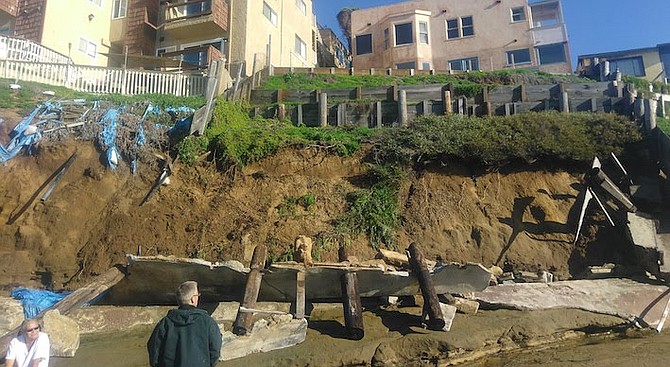 Facebook
Facebook
 X
X
 Instagram
Instagram
 TikTok
TikTok
 Youtube
Youtube

Pelican Point Apartments in Ocean Beach (5107 Narragansett) suffered a bluff collapse in January 2017, and was sold in May, 2018 to Michael Mills for $6.75M.
Less than a year later, there have been no repairs to the bluff below the three-story apartment building perched precariously atop the bluffs.

And as King Tides hit and angry surf took out portions of the OB Pier, it came as no surprise that nature took another swing at Pelican Points un-repaired cliff, sending the lower half of the property onto the cliffs below, and that of the neighboring property.
“When the waves hit, my whole house shakes,“ Alex, a 20-year resident told me. “I’m about three buildings south of Pelican Point, and yes, I heard the crash a few nights ago accompanied by a loud boom, I though earthquake at first, but soon realized we had another bluff collapse…it wasn’t until this morning (Saturday) that I went down there and discovered it was this same bluff and the neighbor's property…it’s pretty gnarly down there, I definitely wouldn’t hang out below it; some of the debris that’s hanging on by a thread was blowing in the wind.”
A precursory search did not yield any emergency permit requests for Pelican Point or the adjacent property at 1783-85 Ocean Front Street.
The Ocean Front property withheld the last storm, but this time nature won and the lower portion of this bluff was torn off along with Pelican Points. Four large telephone poles, including some that washed up on the beach, are strewn along the bottom of the property. Large slabs of concrete litter the cliffs.
“I’ve been watching these cliffs closely and every year the big storms chip away at the bluffs and retaining walls,” Kevin, who is a member of the OB Planning Board spoke to me in an unofficial capacity. “The code requires buildings to be 40 feet from the bluff edge, sometimes more, and they have to build without relying on retaining walls or covering the cliffs in concrete. Walls might stop erosion but over time you end up with no cliff, no beach, and no public access. But since these buildings and walls precede the Coastal Act, they’re allowed to keep building walls on public land. The only way that will stop is if a property owner gets caught off guard and their building falls into the ocean. Technically the retaining wall repair permit could be denied but the city always accommodates builders.”
Under San Diego Municipal Code, emergency permits are issued for coastal emergencies defined as ‘a sudden, unexpected occurrence within the Coastal Overlay Zone that demands immediate action to prevent or mitigate loss of or damage to life, health, property, or essential public services…. all emergency Coastal Development Permits shall authorize only the minimum necessary to stabilize the emergency.


Pelican Point Apartments in Ocean Beach (5107 Narragansett) suffered a bluff collapse in January 2017, and was sold in May, 2018 to Michael Mills for $6.75M.
Less than a year later, there have been no repairs to the bluff below the three-story apartment building perched precariously atop the bluffs.

And as King Tides hit and angry surf took out portions of the OB Pier, it came as no surprise that nature took another swing at Pelican Points un-repaired cliff, sending the lower half of the property onto the cliffs below, and that of the neighboring property.
“When the waves hit, my whole house shakes,“ Alex, a 20-year resident told me. “I’m about three buildings south of Pelican Point, and yes, I heard the crash a few nights ago accompanied by a loud boom, I though earthquake at first, but soon realized we had another bluff collapse…it wasn’t until this morning (Saturday) that I went down there and discovered it was this same bluff and the neighbor's property…it’s pretty gnarly down there, I definitely wouldn’t hang out below it; some of the debris that’s hanging on by a thread was blowing in the wind.”
A precursory search did not yield any emergency permit requests for Pelican Point or the adjacent property at 1783-85 Ocean Front Street.
The Ocean Front property withheld the last storm, but this time nature won and the lower portion of this bluff was torn off along with Pelican Points. Four large telephone poles, including some that washed up on the beach, are strewn along the bottom of the property. Large slabs of concrete litter the cliffs.
“I’ve been watching these cliffs closely and every year the big storms chip away at the bluffs and retaining walls,” Kevin, who is a member of the OB Planning Board spoke to me in an unofficial capacity. “The code requires buildings to be 40 feet from the bluff edge, sometimes more, and they have to build without relying on retaining walls or covering the cliffs in concrete. Walls might stop erosion but over time you end up with no cliff, no beach, and no public access. But since these buildings and walls precede the Coastal Act, they’re allowed to keep building walls on public land. The only way that will stop is if a property owner gets caught off guard and their building falls into the ocean. Technically the retaining wall repair permit could be denied but the city always accommodates builders.”
Under San Diego Municipal Code, emergency permits are issued for coastal emergencies defined as ‘a sudden, unexpected occurrence within the Coastal Overlay Zone that demands immediate action to prevent or mitigate loss of or damage to life, health, property, or essential public services…. all emergency Coastal Development Permits shall authorize only the minimum necessary to stabilize the emergency.
Comments